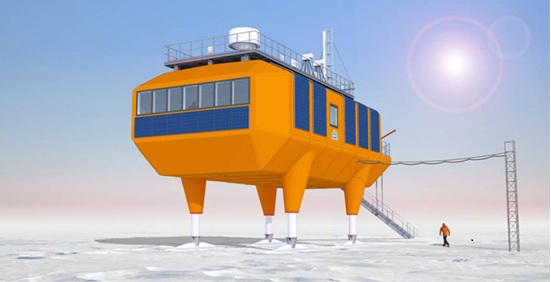
Design for the future of Summit-Isi. Artist’s rendering of the design for the Atmospheric Watch Observatory (AWO), for use at the Summit Observatory. The energy efficient, aerodynamic design maximizes flexibility to suit the ever-changing needs of scientific research. Features include hydraulic, jackable legs to minimizing snow drifting and accumulation, highly insulated glass fiber cladding and integrated photovoltaic arrays.
Over the coming decades, Summit-Isi Station provides a unique capability to measure, monitor, and understand global climate change. Summit-Isi is the only high altitude, high latitude, inland, year-round monitoring station in the Arctic. Summit-Isi offers immediate access to the free troposphere and is relatively free of local influences that could corrupt climate records. As such, it is ideally suited for studies aimed at identifying and understanding long-range, intercontinental transport and its influences on the ice sheet surface, boundary layer, and overlying atmosphere. The pristine and remote location in a year-round dry snow and ice region provides an optimal facility for radiation measurements and remote sensing validation studies. Now, recent pilot studies are highlighting the value of Summit-Isi as a prime site for astronomy and astrophysics observations due to its high altitude, dry and stable atmosphere, and relative ease of access with respect to other polar locations.
The location of Summit-Isi at the drill site of the high resolution GISP2 ice core, drilled to bedrock in 1993, and the ongoing atmospheric and meteorological monitoring initiated in 1989, provides a baseline extending back 140,000 years against which current changes can be assessed. Process studies targeting aspects of the climate system including atmospheric chemistry, air-snow exchange, boundary layer dynamics, energy balance, cloud physics/microphysics and radiative impact conducted at Summit benefit from the suite of long-term, continuous measurements. Summit-Isi is largely free of impacts from regional activities; maintaining the pristine nature of the site is of upmost importance and enables continuation of highly sensitive climatic relevant observations. Current and planned efforts to reduce local impacts include the establishment of a clean air zone, deployment of clean, renewable energy sources and efficient scientific instrumentation in energy efficient structures. Placing camp structures on jackable platforms and reducing reliance on aircraft to transport supplies to Summit-Isi will also reduce the impact of station operations on the region while saving costs and effort associated with maintaining the station. Preserving the integrity of the long term clean air measurements while supporting future growth of the station is the main impetus for current plans to separate atmospheric measurements requiring pristine conditions (at Summit observatory) from activities which do not have clean-air requirements (i.e. geophysical, astrophysical and astronomical observations that will be located at Isi).
Investigations into tropospheric chemistry, snow chemistry, air-snow exchange and climate change will remain prominent, with activities in fields including seismic investigations, space weather, particle physics, astronomy, and astrophysics increasing dramatically. Summit will serve as a test bed for new technology designed for remote operation and remote sensing in harsh environments. Core values of Summit-Isi as a research facility are to provide:
- A collection of the highest quality records for the evaluation of climate change in the northern hemisphere,
- A resource of year-round baseline measurements of climate and chemical variables in the atmosphere,
- Access to a pristine, year-round, and highly unique research location for interdisciplinary research.
The vision for Summit-Isi in the coming decades is for it to become a pre-eminent polar research station integrated into an arctic network of observatories and supporting cutting edge research across disciplines. Working toward this goal requires modularity, innovation, and creativity to enable both growth and development of the station, as well as maintaining a clean air sector for atmospheric measurements. Summit amid global and arctic climate changes will become a critical, perhaps the sole, background site in the northern hemisphere for studies of global climate change, as it will remain free of local and regional influences for decades to come. Conversely, at Isi, the development of a 12-m telescope and piqued interest of the astrophysics community is going to drive significant growth. This requires maintaining a diligent perspective on growing power consumption, and increased resources use of any kind, and demands that creative ‘out-of-the-box’ thinking be applied. The coming challenge is to maintain the unique characteristics of the Summit region that enable collection of climate records while developing Isi to take advantage of the cold dry viewing conditions for astrophysical observations.
This document is prepared by The Science Coordination Office (SCO) for Summit Station and the Greenland Traverse (University of New Hampshire, University of California – Merced, and Dartmouth). This material is based on work supported by the National Science Foundation under awards OPP-1042531 to the University of California – Merced, OPP-1042358 to Dartmouth College, and OPP-1042410 to the University of New Hampshire. Any opinions, findings, conclusions or recommendations expressed in this material are those of the authors and do not necessarily reflect the views of the National Science Foundation.
